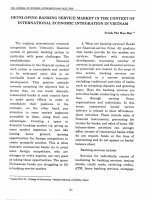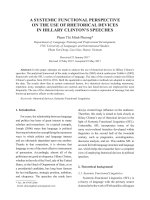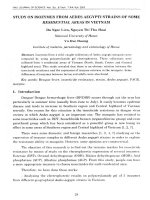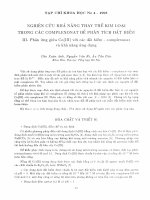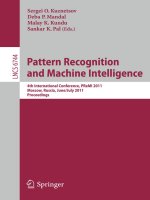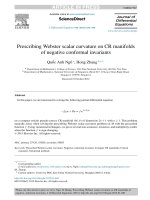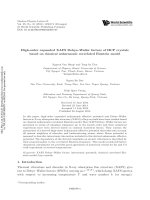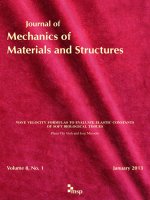DSpace at VNU: International folkloristics: Classic contributions by the founders of folklore
Bạn đang xem bản rút gọn của tài liệu. Xem và tải ngay bản đầy đủ của tài liệu tại đây (282.03 KB, 3 trang )
Nanzan University
International Folkloristics: Classic Contributions by the Founders of Folklore by Alan Dundes
Review by: Hien Thi Nguyen
Asian Folklore Studies, Vol. 60, No. 1 (2001), pp. 149-150
Published by: Nanzan University
Stable URL: .
Accessed: 11/06/2014 03:52
Your use of the JSTOR archive indicates your acceptance of the Terms & Conditions of Use, available at .
/>
.
JSTOR is a not-for-profit service that helps scholars, researchers, and students discover, use, and build upon a wide range of
content in a trusted digital archive. We use information technology and tools to increase productivity and facilitate new forms
of scholarship. For more information about JSTOR, please contact
.
Nanzan University is collaborating with JSTOR to digitize, preserve and extend access to Asian Folklore
Studies.
This content downloaded from 193.104.110.128 on Wed, 11 Jun 2014 03:52:44 AM
All use subject to JSTOR Terms and Conditions
BOOK REVIEWS
GENERAL
DUNDES, ALAN, Editor. International Folkloristics:Classic Contributions by
the Foundersof Folklore.Lanham MD: Rowman & Littlefield Publishers,
Inc., 1999. xiii + 255 pages. Suggestions for further reading, index. Cloth
US$85.00; ISBN 0-8476-9514-X. Paper US$22.95; ISBN 0-8476-9515-8.
Folklore has had a long history since the term "Folk-lore" was coined by William Thoms in
1846, and this book edited by Alan Dundes confirms that international folkloristics has
become an independent, worldwide, and world-class academic discipline. This anthology
under review gives historical views on the evolution of the study of folklore from Jacob Grimm
(the beginning of the nineteenth century) to Kenneth Goldstein (the second half of the twentieth century). The book covers fieldwork methods and the theoretical approaches of structuralism, psychoanalysis, and performance to various genres of folklore such as narratives,
folksongs, rituals, customs, and superstitions.
Dundes chooses letters and articles by "full-fledged folklorists," as well as amateur folklorists such as Yeats (poet), Freud (psychoanalyst), Gramsci (Marxist philosopher of political
protest), whose contributions to folklore study have been evaluated highly. The other scholars-ones whose works should be known by every serious student of folklore in Western
countries-are Jacob Grimm, William Thors, Max Miiller, Kaarle Krohn, Axel Olrik,
Arnold van Gennep, Vladimir Propp, and Carl Wilhelm von Sydow. Dundes presents their
essays in chronological order to give some sense of the evolution of international folkloristics.
The first article, "Circular Concerning the Collecting of Folk Poetry," (1815) by Jacob Grimm
pleads with people to accurately record various folksongs and rhymes, legends in prose, children's tales, humorous trickster tales and jests, festivals, customs, usages, games, superstitions, and so on. The book closes with an article entitled "Strategy in Counting Out: An
Ethnographic Folklore Field Study" (1971) by Kenneth S. Goldstein on ethnographic field
methods for collecting data in natural and induced natural contexts, followed first by nondirected and then by directed interviewing. The circular by Jacob Grimm emphasizes the collecting of different items and the writing of notes of a narrator's place and community, but
Goldstein's essay demonstrates that folklore has to be analyzed as it is actually performed, for
the art of any folklore genre is in its performance.
Dundes states that he is a library fieldworker. What he does as an editor is to select letters and essays and give them extensive headnotes, which include brief biographies of writers
and references to their works and secondary readings, and which sometimes are much longer
than the items themselves. The headnotes provide exceptionally useful information, including comprehensive information about the contributors, their works, and the contexts in
which their essays were written. Probably only a very few editors would have spent the necessary time doing library research to provide all this information for the reader.
The book includes twenty essays reprinted from other sources, more than half of which
were not originally written in English. (Five essays were translated from French and German
[149]
This content downloaded from 193.104.110.128 on Wed, 11 Jun 2014 03:52:44 AM
All use subject to JSTOR Terms and Conditions
150
BOOK REVIEWS
especially for this anthology.) To give the reader an overall history of the development of international folkloristics, Dundes selects essays written mostly by European scholars, some of
whom are from small countries such as Ireland, Estonia, Latvia, and Finland. According to
Dundes, smaller countries have often feared the loss of their national identity, and nationalistic and patriotic scholars have felt the need to preserve as much of their heritage as possible.
Dundes's anthology is a great reference source, especially for folklorists in countries
such as Vietnam. With the support of Ford Foundation, the Vietnam Folklore Institute is
making an effort to translate a number of important essays by international folklorists on the
theories and methods of folklore from various languages into Vietnamese for folklore students, researchers, and faculty at Vietnamese educational and research institutions. When we
finally get competent translations of those essays, which can be used as reference works, interested scholars will be able to better analyze Vietnamese folklore material, and will be able to
write a standard course book for undergraduate and graduate folklore students. So far,
Vietnamese researchers have been influenced by Marxist dogma and scholars of the former
Soviet Union. But they lack the necessary reference works on folklore written in Western
countries such as Germany, France, England, Denmark, Finland, and Hungary.
This anthology is also a good source for people who intend to write books on international folklore in their own languages. Anyone planning such a project will find suggestions
for further reading in the history of folkloristics at the end of Dundes's book.
What we do not see in the anthology (except for an article by Kenneth Goldstein) are
essays by American folklorists on oral-formulaic composition and theoretical issues of folklore
as a performance; nor are there essays on festivals, material folklore, and mythology. Dundes's
intention, however, was not to make an exhaustive anthology, but what he has presented us
with is a book that can be used as a practical reference for the teaching and studying of theories, fields, and genres of folklore.
Hien Thi NGUYEN
Vietnam National University
Hanoi
FOLEY, JOHN MILES. Homer's Traditional Art. University Park, PA:
Pennsylvania State University Press, 1999. xviii + 363 pages. Appendices,
bibliography, index, and index locorum. Cloth US$48.50; ISBN 0-27101870-4.
Readers of Foley's article "Oral poetry" in the latest volume of the Enzyklopddie des Mdrchens
(EM, Vol. 10, 2000) know about the author's standing as one of the most proficient scholars
of the Homeric question. He is able to quote about twenty larger publications of his own concerning his field. Foley, who is the founding editor of the periodical Oral Traditionand director
of the Center for Studies in Oral Tradition at the University of Missouri-Columbia, is asking
again, "How far were the Iliad and the Odysseyrooted in oral tradition?"His account is in effect a
survey ofthe importantsteps forwardthat oral poetry research has made in recent years. Homeric
epics amount to a "cultural encyclopaedia" but with Foley's approach the point is another one.
In a previous publication, FOLEY (1991) refers to Homer's "traditional art" as "verbal
art," and as "very immanent" but not as literature. Homer's epics derive from an oral tradition, as most scholars around the world agree. However, some still wonder whether Homer
had a stylus in his hand. Where once in the Romantic era Homer was lionized as the "blind
singer of tales," the "voice of the people" that gave back to the people its own texts in a purified form, nowadays scholarly interest has centered on oral verse composition tied to specific
This content downloaded from 193.104.110.128 on Wed, 11 Jun 2014 03:52:44 AM
All use subject to JSTOR Terms and Conditions
